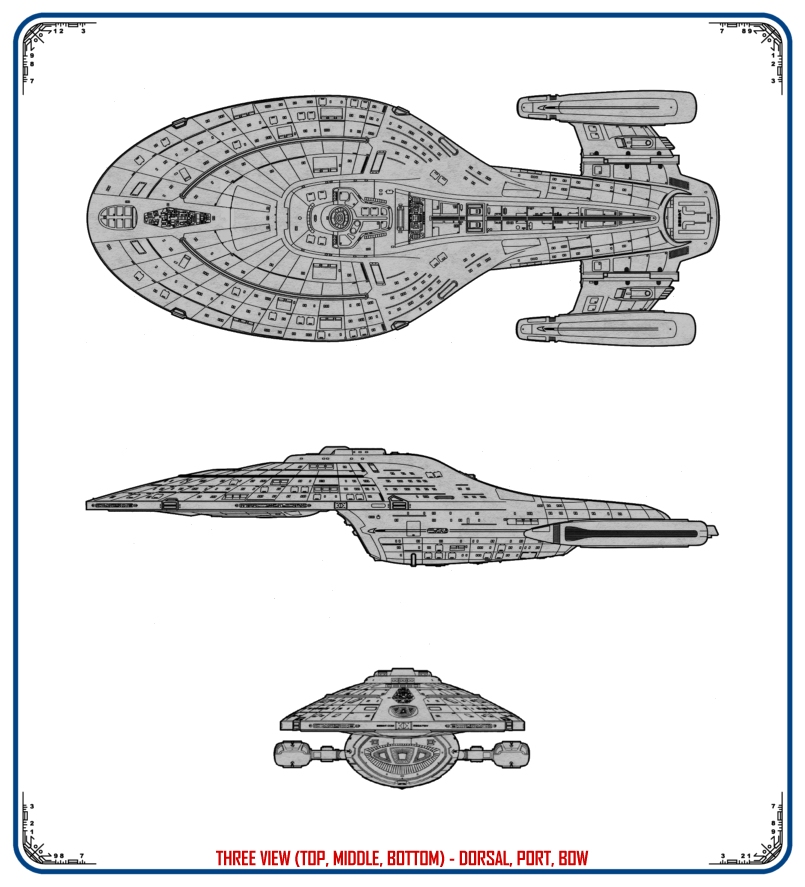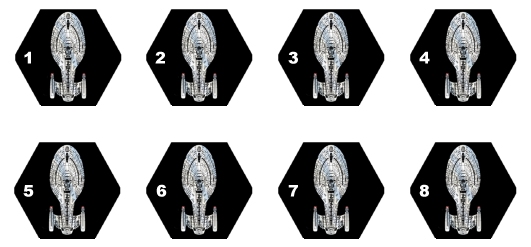![]()
Intrepid Class ● Cruiser ● United Federation of Planets

|
AS
MUCH AS THE GALAXY CLASS WAS A
DEPARTURE from the
linear, industrial-shaped Constitution Refit
which dominated the Star Trek films from 1979 until 1987, the Intrepid Class was
an even more radical departure. Debuting with the fourth Star Trek
television series (the often-maligned Star Trek: Voyager) the Intrepid
shares little in common with its progenitor the
Constitution.
The "saucer" has ceased to be a saucer altogether and the engineering
hull has been greatly merged with the elliptical primary hull. The warp
engines are stubby and diminutive compared to those of the Constitution,
especially when one considers the fact that the Constitution and the Intrepid
are of similar size. And the Intrepid is also the first featured ship in a
Star Trek TV series to have not been larger than the ship featured in the series before it:
the Intrepid is about half the length of the Galaxy, and possesses about a
quarter of the apparent mass of the Galaxy. — BRT |

| Construction Data: Model Numbers- Ship Class- Date Entering Service- Number Constructed |
MK I * XIII 2371 A.D. classified |
MK II * XIII 2377 A.D. classified |
| Hull Data: Superstructure Points- Damage Chart- Size Length- Width- Height- Weight- Cargo Cargo Units- Cargo Capacity- Landing Capability- |
52 C 344 meters 130 meters 63 meters 234,500 tons 75 units 3,750 tons Yes! |
57 C 346 meters 130 meters 65 meters 247,200 tons 75 units 3,750 tons Yes! |
| Equipment Data: Control Computer Type- Transporters- Standard 6-person- Emergency 22-person- cargo- |
MBT-07 4 4 1 |
MBT-07 4 4 1 |
| Other Data: Crew- Passengers- Shuttlecraft- |
200 5 4 |
185 10 4 |
| Engines and Power Data: Total Power Units Available- Movement Point Ratio- Warp Core Type- Power Units Available- Stress Charts- Maximum Safe Cruising Speed- Emergency Speed- Impulse Engine Type- Power Units Available- |
75 2/1 FNWD-3A 60 M/K Warp 8 Warp 9.9 FNIS-100 15 |
93 2/1 FNWD-3B 68 M/K Warp 8 Warp 9.9 FNIS-200 25 |
| Weapons and Firing Data: Beam Weapon Type- Number- Firing Arcs- Firing Chart- Maximum Power- Damage Modifiers +3 +2 +1 Missile Weapon Type- Number- Firing Arcs- Firing Chart- Power To Arm- Damage- Missile Weapon Type- Number- Firing Arcs- Firing Chart- Power To Arm- Damage- |
FAHW-20 8 in four banks 2f/p, 2f/s, 2a/p, 2a/s T 12 (1 - 6) (7 - 14) (15 - 18) FP-9 4 in two bays 2f, 2a T 1 18 Tricobalt Devices 2 F M 5 30 |
FAHW-23 8 in four banks 2f/p, 2f/s, 2a/p, 2a/s U 15 (1 - 7) (8 - 14) (15 - 20) FP-9 4 in two bays 2f, 2a T 1 18 Tricobalt Devices 2 F M 5 30 |
| Shields Data: Deflector Shield Type- Shield Point Ratio- Maximum Shield Power- |
NGSS-G 1/3 24 |
NGSS-J 1/3 33 |
| Defense Factor- Weapon Damage Factor- |
257.9
** 149 ** |
318.9
** 167.4 ** |
* Denotes completely hypothetical
model number and stats, devised by Brad R. Torgersen.
** D and WDF numbers provided by Bryan Jecko.
Thanks Bryan!

CLICK HEX GAME PIECES TO VIEW AND PRINT SEPARATELY